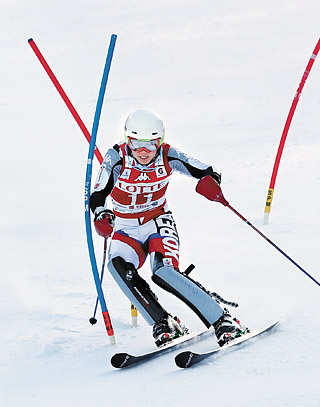Yongpyong alpine slope gives skiers a hard time

Park Jae-yoon, member of the alpine ski national team, races down through rotary gates at YongPyong Resort Alpine Ski Arena in Pyeonchang County, Gangwon, on the first day of the 2017 FIS Alpine Ski Far East Cup. [YONHAP]
Despite the small size of the tournament, the number of contestants doubled compared to similar events previously held at the same venue, as this was the first test event held at the 2018 PyeongChang Olympics Alpine Ski trail. A total of 135 alpine skiers from 13 different countries competed.
After the first and second trials, only 18.5 percent of the competitors - 18 men and 7 women - were able to finish the race. Of the 13 female Korean skiers, one completed the race. Last year at the Far East Cup, held at the same site, the race completion rate was 50 percent, or 39 out of 78 skiers.
Due to the change in the quality of the snow, skiers who competed in the previous Far East Cup found the trial much more challenging. The International Ski Federation said the course environment has been adjusted to fit an “Olympic level” of skiing.
“Unlike other domestic tournaments, they sprayed water on slopes,” said Shin Bok-soo, alpine ski national team coach. “With a negative Celsius temperature, the course got hard and slippery as the water froze. This is how the course is set up in bigger tournaments such as the Olympics or the World Cup.”
“I’ve never raced in this kind of course in domestic events,” said Kim Hyun-tae, a member of the alpine ski national team.
Jung Dong-hyun is more familiar with the new quality of snow, as he has more international experience and recently finished 14th at the Croatia World Cup rotary.
“It felt like skiing on ice compared to average years,” said Okoshi Ryunosuke, a regular attendant of the Far East Cup since 2011 and men’s winner of the Olympic test event.
In a field with higher-ranked skiers, the amount of snow on each slope becomes a significant factor. When the slopes are soft with a lot of snow, skiers coming down later may be disadvantaged since the amount of snow reduces after each skier’s pass. To avoid this, freezing the snow allows every skier to compete in the same conditions. For skiers who were only used to soft slopes, many were unable to finish the race.
The effects of gates were also a big factor. For rotary skiing, skiers come down the slope in a zig-zag pattern, passing through 60 gates within 200 meters (656 feet). This requires both speed and flexibility.
“This event was challenging because the gap between the gates were dense and the angles were bigger,” said Cho Gwang-ho, a member of the alpine ski national team.
During the 2014 Sochi Winter Olympics, of the 117 male rotary alpine skiers, only 43 were able to finish the race, a 36.7 percent completion rate. This season, the completion rate of the Alpine World Cup after six trials was 36.6 percent.
“It’ll help a lot if I ski more on the Olympic course,” said Kim Hyun-tae, who finished with a time of 1 minute and 45 seconds, the best among the other Korean alpine skiers.
BY KIM JI-HAN [kang.yoorim@joongang.co.kr]










with the Korea JoongAng Daily
To write comments, please log in to one of the accounts.
Standards Board Policy (0/250자)